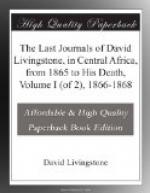On the watershed we have still the rounded granitic hills jutting above the plains (if such they may be called) which are all ups and downs, and furrowed with innumerable running rills, the sources of the Rovuma and Loendi. The highest rock observed with mica schist was at an altitude of 3440 feet. The same uneven country prevails as we proceed from the watershed about forty miles down to the Lake, and a great deal of quartz in small fragments renders travelling-very difficult. Near the Lake, and along its eastern shore, we have mica schist and gneiss foliated, with a great deal of hornblende; but the most remarkable feature of it is that the rocks are all tilted on edge, or slightly inclined to the Lake. The active agent in effecting this is not visible. It looks as if a sudden rent had been made, so as to form the Lake, and tilt all these rocks nearly over. On the east side of the lower part of the Lake we have two ranges of mountains, evidently granitic: the nearer one covered with small trees and lower than the other; the other jagged and bare, or of the granitic forms. But in all this country no fossil-yielding rock was visible except the grey sandstone referred to at the beginning of this note. The rocks are chiefly the old crystalline forms.
One fine straight tall tree in the hollows seemed a species of fig: its fruit was just forming, but it was too high for me to ascertain its species. The natives don’t eat the fruit, but they eat the large grubs which come out of it. The leaves were fifteen inches long by five broad: they call it Unguengo.
29th July, 1866.—At Magola’s village. Although we are now rid of the sepoys, we cannot yet congratulate ourselves on being rid of the lazy habits of lying down in the path which they introduced. A strong scud comes up from the south bringing much moisture with it: it blows so hard above, this may be a storm on the coast. Temperature in mornings 55 deg.
30th July, 1866.—A short march brought us to Pezimba’s village, which consists of 200 houses and huts. It is placed very nicely on a knoll between two burns, which, as usual, are made use of for irrigating peas in winter time. The headman said that if we left now we had a good piece of jungle before us, and would sleep twice in it before reaching Mbanga. We therefore remained. An Arab party, hearing of our approach, took a circuitous route among the mountains to avoid coming in contact with us. In travelling to Pezimba’s we had commenced our western descent to the Lake, for we were now lower than Magola’s by 300 feet. We crossed many rivulets and the Lochesi, a good-sized stream. The watershed parts some streams for Loendi and some for Rovuma. There is now a decided scantiness of trees. Many of the hill-tops are covered with grass or another plant; there is pleasure now in seeing them bare. Ferns, rhododendrons, and a foliaged tree, which looks in the distance like silver-fir, are met with.




